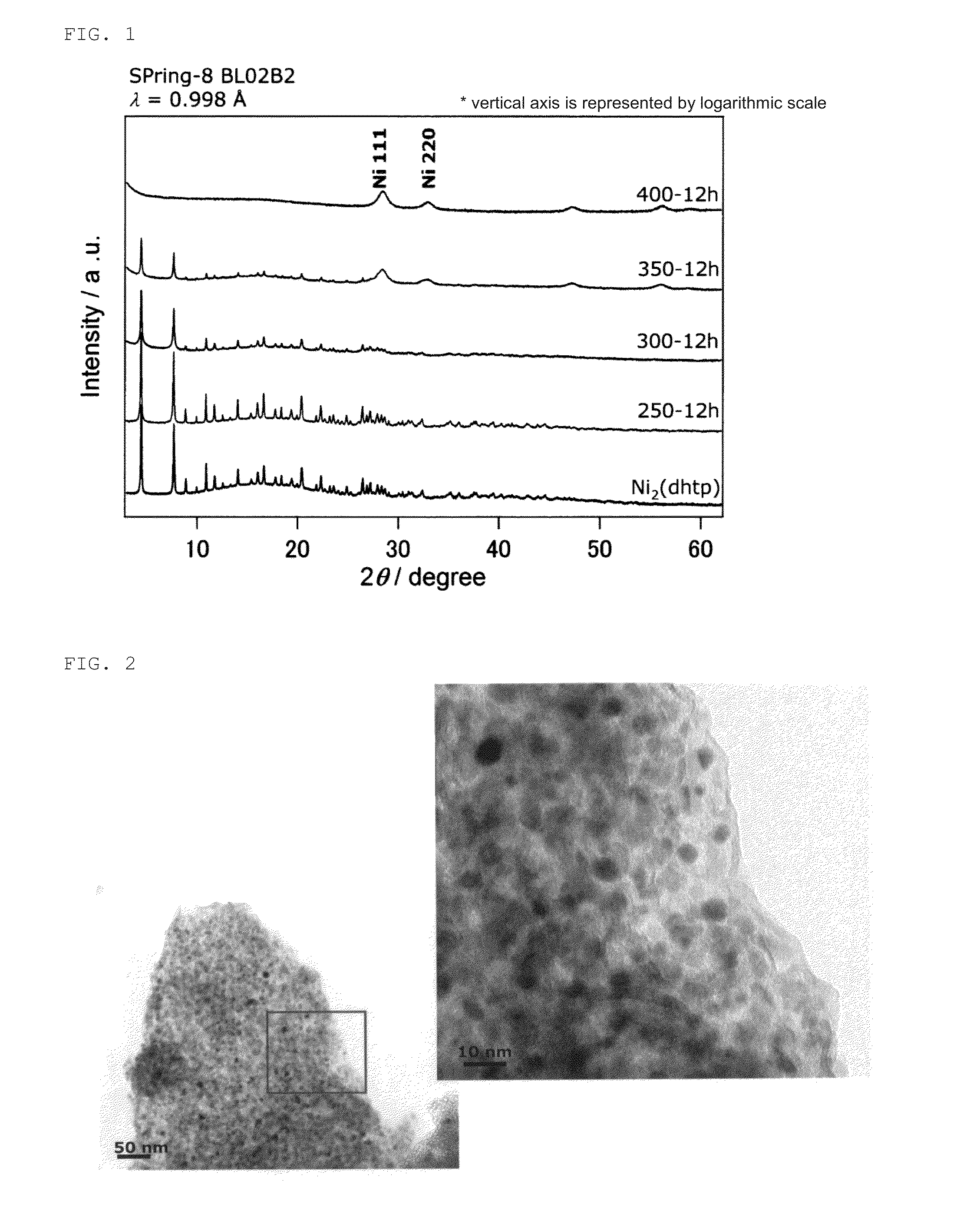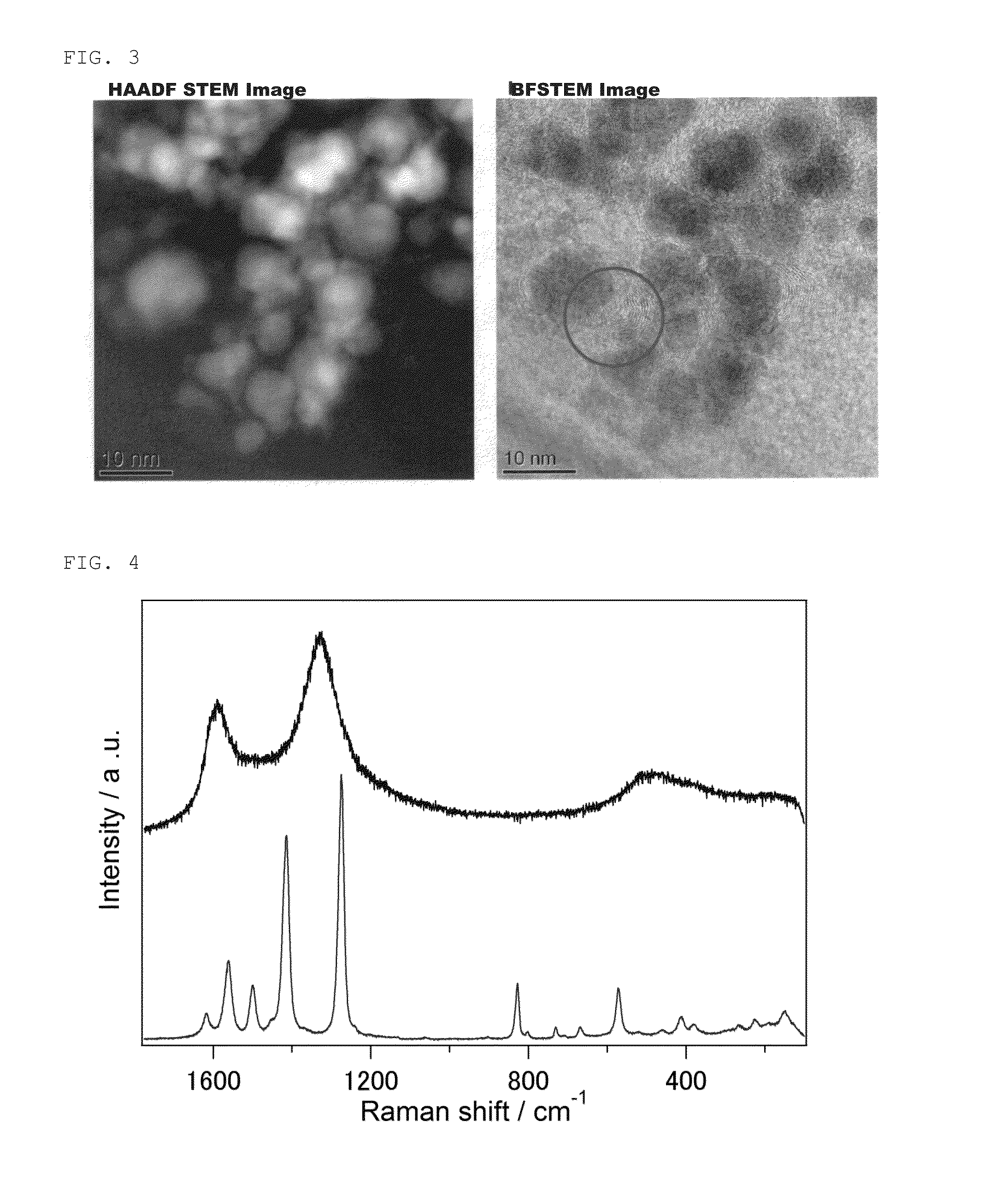Metal nanoparticle complex and method for producing same
a technology of metal nanoparticles and complexes, which is applied in the direction of organic compounds/hydrides/coordination complexes, physical/chemical process catalysts, cell components, etc., can solve the problems of reduced precipitation amount of ruthenium metal in the vicinity of the center of the mof, increased size of ruthenium metal precipitated in the vicinity of the surface, and limited effect of the composite of metal nanoparticles and pcp, etc., to achieve high activity ratio ratio ratio
- Summary
- Abstract
- Description
- Claims
- Application Information
AI Technical Summary
Benefits of technology
Problems solved by technology
Method used
Image
Examples
production example 1
Preparation of PCP Complex
[0076]2,000 ml of DMF-ethanol-water (1:1:1 by volume) serving as a solvent, Ni (NO3)2.6H2O (23.8 g), and 2,5-dihydroxyterephthalic acid (H4dhtp, 4.8 g) were added to a 3,000-ml recovery flask, and a reaction was conducted with stirring at 100° C. for 5 days. A precipitated three-dimensional structure metal complex (Ni2(dhtp)) was recovered by suction filtration and washed with methanol and water. Then, the resultant was dried under reduced pressure at 25° C. for 24 hours to obtain 12 g of an intended metal complex (Ni2 (dhtp)). It was confirmed by powder X-ray structure analysis that the intended metal complex was obtained. The obtained metal complex is sometimes hereinafter referred to as “Ni-MOF-74”.
production example 2
Preparation of PCP Complex
[0077]200 ml of DMF-ethanol-water (1:1:1 by volume) serving as a solvent, Co (NO3)2.6H2O (2.4 g), and 2,5-dihydroxyterephthalic acid (H4dhtp, 0.5 g) were added to a 300-ml recovery flask, and a reaction was conducted with stirring at 100° C. for 5 days. A precipitated three-dimensional structure metal complex (Co2(dhtp)) was recovered by suction filtration and washed with methanol and water. Then, the resultant was dried under reduced pressure at 25° C. for 24 hours to obtain 0.8 g of an intended metal complex (Co2(dhtp)). It was confirmed by powder X-ray structure analysis that the intended metal complex was obtained.
example 1
[0078]The Ni complex obtained in Production Example 1 was heated under reduced pressure (under vacuum) through use of a vacuum pump at each reaction temperature and each reaction time of Table 2 below to manufacture a Ni composite of the present invention.
TABLE 2Synthesis condition and batch name6 hours12 hours24 hours3 days7 days250° C.250-6 h250-12 h250-24 h250-7 d300° C.300-6 h300-12 h300-24 h300-3 d350° C.350-6 h350-12 h350-24 h400° C.400-6 h400-12 h400-24 h
[0079]FIG. 1 shows results of powder X-ray diffraction of the obtained Ni composite. FIG. 2 shows scanning transmission electron microscope (STEM) images of the obtained Ni composite. FIG. 3 shows high-resolution transmission electron microscope (HRTEM) images of the obtained Ni composite. FIGS. 4 and 5 show Raman measurement results of the obtained Ni composite. FIG. 6 shows results of N2 adsorption at 77 K of the obtained Ni composite.
PUM
| Property | Measurement | Unit |
|---|---|---|
| temperature | aaaaa | aaaaa |
| temperature | aaaaa | aaaaa |
| temperature | aaaaa | aaaaa |
Abstract
Description
Claims
Application Information
 Login to View More
Login to View More - R&D
- Intellectual Property
- Life Sciences
- Materials
- Tech Scout
- Unparalleled Data Quality
- Higher Quality Content
- 60% Fewer Hallucinations
Browse by: Latest US Patents, China's latest patents, Technical Efficacy Thesaurus, Application Domain, Technology Topic, Popular Technical Reports.
© 2025 PatSnap. All rights reserved.Legal|Privacy policy|Modern Slavery Act Transparency Statement|Sitemap|About US| Contact US: help@patsnap.com



